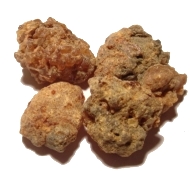
In polymer chemistry and materials science, a resin is a solid or highly viscous substance of plant or synthetic origin that is typically convertible into polymers. Resins are usually mixtures of organic compounds. This article focuses mainly on naturally occurring resins.

Myrrh is a gum-resin extracted from a number of small, thorny tree species of the genus Commiphora. Myrrh resin has been used throughout history as a perfume, incense and medicine. Myrrh mixed with posca or wine was widely used in many ancient cultures to produce pleasurable feelings and as an anti-inflammatory and analgesic.

The Burseraceae are a moderate-sized family of 17-19 genera and about 540 species of woody flowering plants. The actual numbers given in taxonomic sources differ according to taxonomic revision at the time of writing. The Burseraceae are also known as the torchwood family, the frankincense and myrrh family, or simply the incense tree family. The family includes both trees and shrubs; its species are native to tropical regions of Africa, Asia, Australasia, and the Americas.

The genus of the myrrhs, Commiphora, is the most species-rich genus of flowering plants in the frankincense and myrrh family, Burseraceae. The genus contains approximately 190 species of shrubs and trees, which are distributed throughout the (sub-) tropical regions of Africa, the western Indian Ocean islands, the Arabian Peninsula, India, and South America. The genus is drought-tolerant and common throughout the xerophytic scrub, seasonally dry tropical forests, and woodlands of these regions.

Commiphora wightii, with common names Indian bdellium-tree, gugal, guggul, gugul, or mukul myrrh tree, is a flowering plant in the family Burseraceae, which produces a fragrant resin called gugal, guggul or gugul, that is used in incense and vedic medicine. The species is native to southern Pakistan and western India. It prefers arid and semi-arid climates and is tolerant of poor soil.

Commiphora myrrha, called myrrh, African myrrh, herabol myrrh, Somali myrrhor, common myrrh, is a tree in the Burseraceae family. It is one of the primary trees used in the production of myrrh, a resin made from dried tree sap. The tree is native to the Arabian peninsula and to Africa. It is called 'mur' (المر) in Arabic, meaning bitter. It famously comes from Mecca, so it is called 'Mur Makki'.

Commiphora gileadensis, the Arabian balsam tree, is a shrub species in the genus Commiphora growing in Saudi Arabia, Yemen, southern Oman, Sudan and in southeast Egypt where it may have been introduced. Other common names for the plant include balm of Gilead and Mecca myrrh, but this is due to historical confusion between several plants and the historically important expensive perfumes and drugs obtained from them.
Maytenus dhofarensis is a species of plant in the family Celastraceae and is found in Oman and Yemen. It is an intricately branched spiny shrub or small tree with its leaves arranged alternately or clustered on short shoots. The flowers have white or cream petals and the fruit are purple or red. It is threatened by habitat loss.

Stacte and nataph are names used for one component of the Solomon's Temple incense, the Ketoret, specified in the Book of Exodus. Variously translated to the Greek term or to an unspecified "gum resin" or similar, it was to be mixed in equal parts with onycha, galbanum and mixed with pure frankincense and they were to "beat some of it very small" for burning on the altar of the tabernacle.

Moringa peregrina is a species of flowering plant in the family Moringaceae that is native to the Horn of Africa, Sudan, Egypt, the Arabian Peninsula, and as far north as Syria. It grows on rocky wadis and on cliffs in drier areas.

The Arabian Peninsula coastal fog desert, also known as the Southwestern Arabian coastal xeric scrub, is desert ecoregion on the southern coasts of the Arabian Peninsula, which experiences thick fogs where visibility may be reduced to 10 metres (33 ft). It is classed as an Afrotropical fog desert
Commiphora africana, commonly called African myrrh, is a small deciduous tree belonging to the Burseraceae, a family akin to the Anacardiaceae, occurring widely over sub-Saharan Africa in Angola, Botswana, Burkina Faso, Chad, Eswatini, Eritrea, Ethiopia, Kenya, Mali, Mauritania, Mozambique, Namibia, Niger, Senegal, Somalia, South Africa, Sudan, Tanzania, Uganda, Zambia and Zimbabwe. On sandy soils this species sometimes forms pure stands, deserving consideration as a plant community or association.
Balanites rotundifolia, known in Swahili as Mbamba ngoma is a spiny bush or small tree from eastern Africa and southern Arabia. It is a member of the caltrop family, Zygophyllaceae.

Sterculia africana or African star-chestnut is a deciduous tree, belonging to the genus Sterculia and the family Malvaceae. The species is sometimes called the "mopopaja tree". It is distributed throughout Northeast Africa to Arabia.
Pancratium maximum is a perennial glabrous herb that grows up to 30 cm tall arising from a bulb. It is endemic to south western Arabia.
Senna holosericea is a perennial herb with yellow flowers that is native to the Arabian peninsula, Chad, Djibouti, Egypt, Eritrea, Ethiopia, India, Pakistan, Socotra, Somalia and Sudan.
Cyphostemma ternatum is a perennial climbing herb that grows up to 2m. It is edible and distributed throughout Northeast Africa to South Arabia. ternatum in Latin means "arranged in threes" and alludes to the arrangement of the leaves.

The Southwestern Arabian foothills savanna, also known as the Southwestern Arabian Escarpment shrublands and woodlands, is a desert and xeric shrubland ecoregion of the southern Arabian Peninsula, covering portions of Saudi Arabia, Yemen, and Oman.
Melhania phillipsiae is a plant in the family Malvaceae. It is native to Africa and the Arabian Peninsula.

The South Arabian fog woodlands, shrublands, and dune is an ecoregion in Oman and Yemen. The fog woodlands lie on mountainsides which slope southeastwards towards the Arabian Sea. The mountains intercept moisture-bearing winds from the Arabian Sea, creating orographic precipitation and frequent fogs that sustain unique woodlands and shrublands in a desert region.













